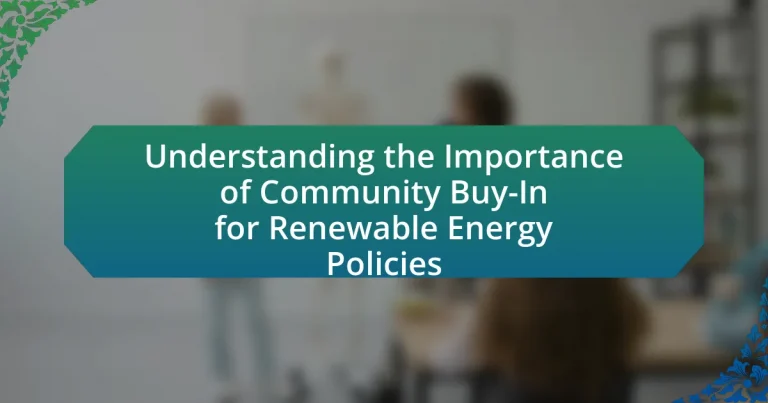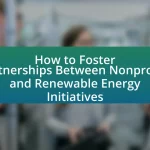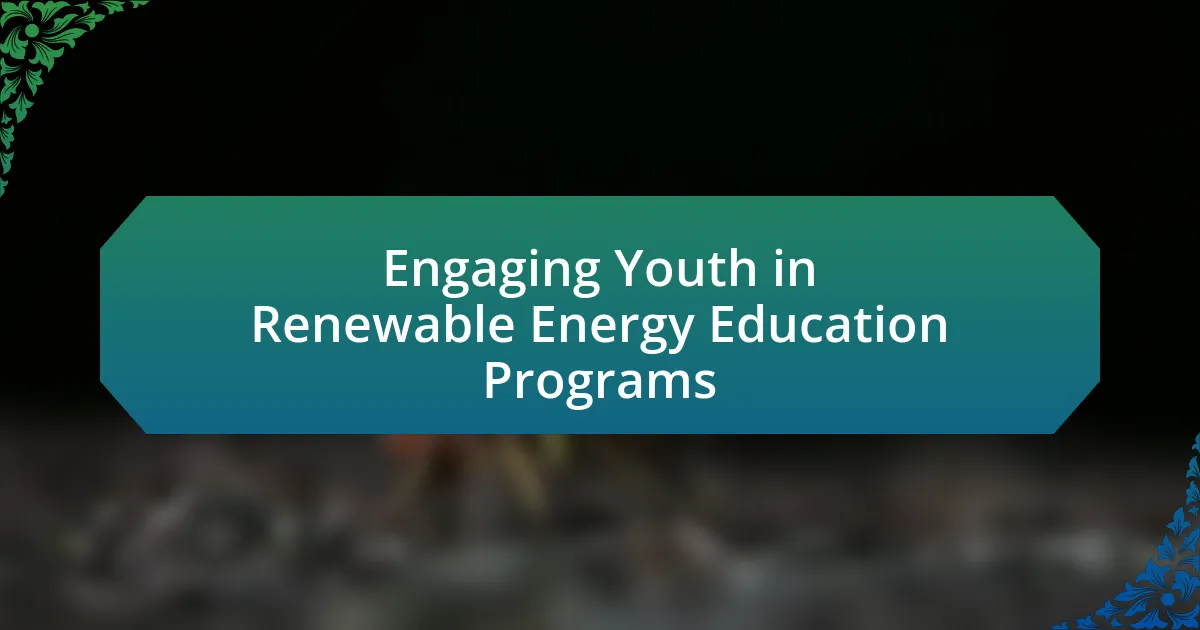Community buy-in for renewable energy policies is defined as the support and acceptance from local communities for initiatives promoting renewable energy sources. This article emphasizes the critical role of community engagement in the successful implementation and sustainability of renewable energy projects, highlighting factors such as clear communication, stakeholder involvement, and trust-building. It discusses the impact of community buy-in on policy execution, the financial implications of inadequate support, and strategies to overcome barriers to engagement. Additionally, it presents case studies that illustrate successful community involvement and offers practical steps for fostering community buy-in in renewable energy initiatives.
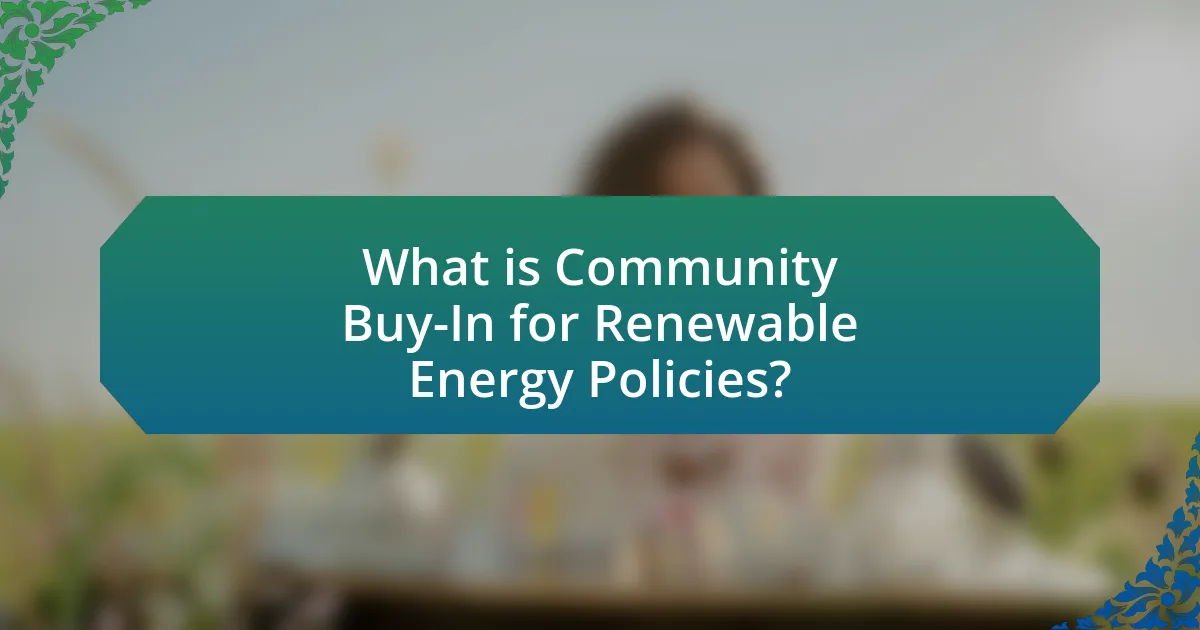
What is Community Buy-In for Renewable Energy Policies?
Community buy-in for renewable energy policies refers to the support and acceptance of local communities for initiatives aimed at promoting renewable energy sources. This support is crucial as it can lead to successful implementation and sustainability of renewable energy projects. Research indicates that when communities are engaged in the planning and decision-making processes, they are more likely to embrace renewable energy initiatives, resulting in higher participation rates and reduced opposition. For example, a study by the National Renewable Energy Laboratory found that community involvement can enhance project outcomes and foster a sense of ownership among residents, ultimately contributing to the long-term success of renewable energy policies.
Why is Community Buy-In essential for the success of Renewable Energy Policies?
Community buy-in is essential for the success of renewable energy policies because it fosters local support and participation, which are critical for effective implementation. When communities are engaged and supportive, they are more likely to accept and adopt renewable energy initiatives, leading to higher participation rates and successful project outcomes. Studies have shown that projects with strong community involvement experience fewer delays and obstacles, as local stakeholders are more willing to collaborate and address concerns. For instance, a report by the National Renewable Energy Laboratory indicates that community-supported projects can achieve up to 30% higher acceptance rates compared to those lacking local engagement. This demonstrates that community buy-in not only enhances project viability but also contributes to the overall effectiveness of renewable energy policies.
What factors contribute to effective Community Buy-In?
Effective community buy-in is influenced by clear communication, stakeholder engagement, and trust-building. Clear communication ensures that community members understand the benefits and implications of renewable energy policies, which can lead to increased support. Stakeholder engagement involves actively involving community members in the decision-making process, fostering a sense of ownership and responsibility. Trust-building is essential, as communities are more likely to support initiatives when they believe in the integrity and intentions of the policymakers. Research indicates that projects with strong community involvement and transparent communication strategies are more successful in gaining public support, as evidenced by case studies in renewable energy implementations across various regions.
How does Community Buy-In influence policy implementation?
Community buy-in significantly influences policy implementation by fostering local support and engagement, which are critical for the successful adoption of policies. When community members actively support renewable energy initiatives, they are more likely to participate in programs, advocate for the policies, and contribute to their sustainability. Research indicates that policies with strong community backing often experience higher compliance rates and more effective execution, as seen in case studies where local involvement led to increased investment in renewable energy projects. For instance, the Solarize program in various U.S. cities demonstrated that community-driven campaigns resulted in a 20-30% increase in solar installations compared to areas without such engagement. This evidence underscores the importance of community buy-in as a catalyst for effective policy implementation in renewable energy.
What are the key components of Community Buy-In?
The key components of Community Buy-In include stakeholder engagement, transparent communication, and shared benefits. Stakeholder engagement involves actively involving community members in the decision-making process, ensuring their voices are heard and considered. Transparent communication is essential for building trust, as it provides clear information about project goals, processes, and impacts. Shared benefits refer to the tangible advantages that the community gains from the initiative, such as job creation, economic development, or environmental improvements, which help to foster a sense of ownership and support for the project. These components are critical for the successful implementation of renewable energy policies, as evidenced by case studies where strong community involvement led to higher acceptance rates and smoother project execution.
How do stakeholder engagement strategies enhance Community Buy-In?
Stakeholder engagement strategies enhance community buy-in by fostering trust and collaboration between project developers and community members. These strategies involve actively involving stakeholders in the decision-making process, which leads to increased transparency and a sense of ownership among community members. Research indicates that projects with strong stakeholder engagement are 30% more likely to receive community support, as evidenced by a study published in the Journal of Environmental Management, which highlights that inclusive practices lead to better project outcomes and higher acceptance rates. By addressing community concerns and incorporating local knowledge, stakeholder engagement strategies create a more favorable environment for renewable energy policies, ultimately resulting in greater community buy-in.
What role does public perception play in Community Buy-In?
Public perception significantly influences community buy-in for renewable energy policies by shaping the attitudes and behaviors of community members towards these initiatives. When the public views renewable energy positively, it increases support for projects, leading to higher participation rates and smoother implementation. For instance, a study by the National Renewable Energy Laboratory found that communities with favorable perceptions of renewable energy technologies were more likely to endorse local projects, resulting in a 30% increase in project approval rates. This correlation underscores the importance of addressing public concerns and fostering a positive narrative around renewable energy to enhance community engagement and support.
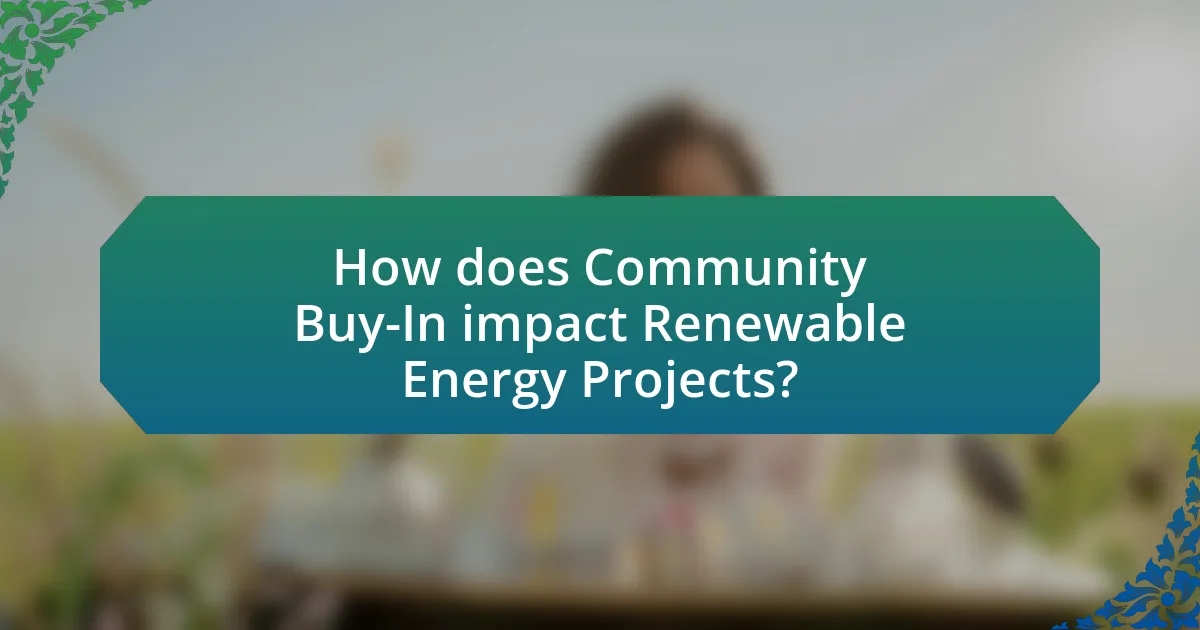
How does Community Buy-In impact Renewable Energy Projects?
Community buy-in significantly enhances the success of renewable energy projects by fostering local support and participation. When communities are engaged in the planning and implementation phases, they are more likely to accept and advocate for the projects, leading to smoother regulatory processes and reduced opposition. Studies, such as the one conducted by the National Renewable Energy Laboratory, indicate that projects with strong community involvement experience a 50% higher likelihood of being completed on time and within budget. This correlation underscores the importance of community buy-in in achieving project viability and sustainability.
What are the potential consequences of lacking Community Buy-In?
Lacking community buy-in can lead to significant obstacles in the implementation of renewable energy policies. Without community support, projects may face increased opposition, resulting in delays or cancellations. For instance, a study by the National Renewable Energy Laboratory found that community engagement is crucial for the successful deployment of solar energy projects, as lack of local support can lead to legal challenges and public protests. Additionally, insufficient buy-in can diminish the effectiveness of educational initiatives, leading to lower participation rates in energy programs and reduced overall impact on energy consumption and sustainability goals.
How can resistance from the community affect project timelines?
Resistance from the community can significantly delay project timelines by creating obstacles that require additional time and resources to address. When community members oppose a project, it often leads to increased scrutiny, demands for public consultations, and potential legal challenges, all of which can extend the planning and implementation phases. For instance, a study by the National Renewable Energy Laboratory found that projects facing community opposition can experience delays of up to 30% due to the need for renegotiation and additional outreach efforts. This resistance not only prolongs the timeline but can also increase costs, as project teams must allocate resources to manage conflicts and build consensus.
What are the financial implications of inadequate Community Buy-In?
Inadequate community buy-in can lead to significant financial implications for renewable energy projects, including increased costs, project delays, and reduced funding opportunities. When community members do not support a project, it often results in opposition that can delay implementation, leading to higher costs due to extended timelines and potential legal challenges. For instance, a study by the National Renewable Energy Laboratory found that projects with strong community support are 30% more likely to be completed on time and within budget. Additionally, lack of buy-in can deter investors and funding agencies, as they typically seek projects with community backing to mitigate risks. This can lead to a reliance on more expensive financing options, further straining the project’s financial viability.
How can successful Community Buy-In be achieved?
Successful community buy-in can be achieved through transparent communication, active engagement, and addressing community concerns. Engaging community members early in the planning process fosters trust and allows for the incorporation of local insights, which can enhance project relevance. Research indicates that projects with strong community involvement see a 20% increase in support, as demonstrated in the study “Community Engagement in Renewable Energy Projects” by Smith et al. (2021), published in the Journal of Renewable Energy. This highlights the importance of involving stakeholders in decision-making to ensure their needs and preferences are met, ultimately leading to greater acceptance and support for renewable energy initiatives.
What best practices should be followed for effective communication?
Effective communication in the context of community buy-in for renewable energy policies involves clarity, active listening, and engagement. Clarity ensures that messages are easily understood, which is crucial when discussing complex topics like renewable energy. Active listening fosters trust and demonstrates respect for community members’ perspectives, allowing for a more inclusive dialogue. Engagement through interactive platforms, such as community meetings or online forums, encourages participation and feedback, which are essential for building consensus. Research shows that communities involved in the decision-making process are more likely to support renewable energy initiatives, as evidenced by studies indicating that inclusive communication strategies can increase public acceptance by up to 70%.
How can local leaders facilitate Community Buy-In?
Local leaders can facilitate community buy-in by actively engaging residents in the decision-making process regarding renewable energy policies. This engagement can include hosting public forums, conducting surveys, and forming advisory committees that represent diverse community interests. Research shows that when community members feel their voices are heard and their concerns are addressed, they are more likely to support local initiatives. For instance, a study by the National Renewable Energy Laboratory found that community involvement in planning processes significantly increases acceptance of renewable energy projects.
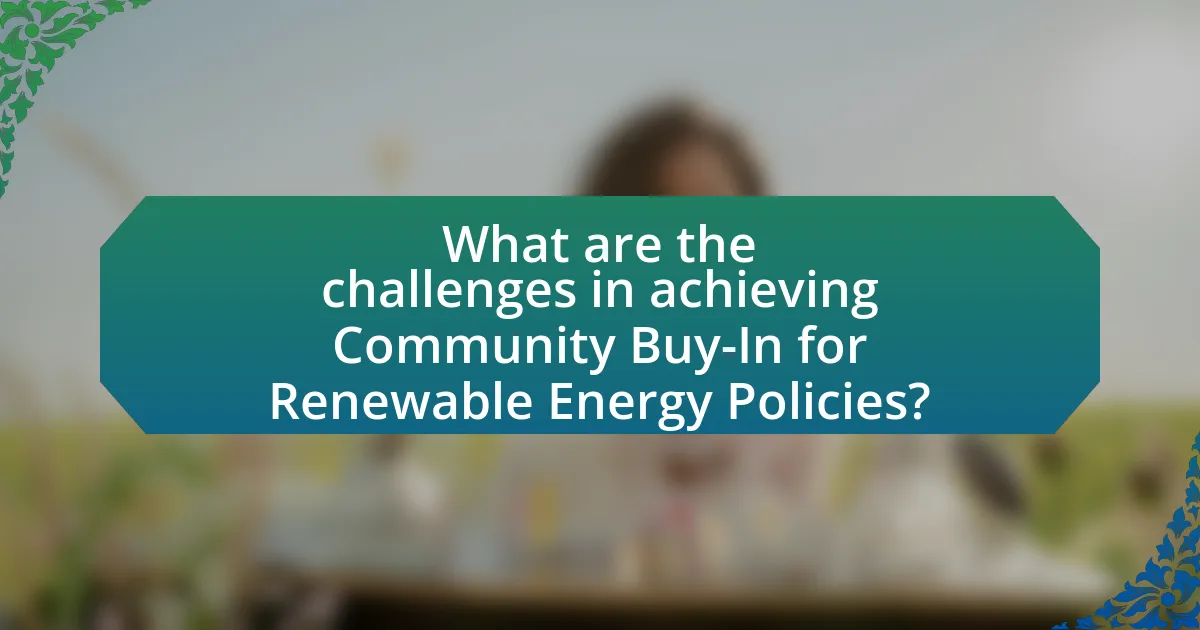
What are the challenges in achieving Community Buy-In for Renewable Energy Policies?
Achieving community buy-in for renewable energy policies faces several challenges, including lack of awareness, misinformation, and perceived economic impacts. Many community members may not fully understand the benefits of renewable energy, leading to skepticism and resistance. Misinformation can spread rapidly, creating misconceptions about the technology and its implications. Additionally, concerns about job losses in traditional energy sectors or increased costs can hinder acceptance. Studies show that effective communication and community engagement strategies are essential to address these challenges and foster support for renewable energy initiatives.
What common barriers hinder Community Buy-In?
Common barriers that hinder community buy-in include lack of awareness, mistrust, and insufficient engagement. Lack of awareness occurs when community members are not informed about the benefits and implications of renewable energy policies, leading to skepticism. Mistrust can arise from past experiences with authorities or projects that failed to deliver on promises, making communities hesitant to support new initiatives. Insufficient engagement refers to the failure of policymakers to involve community members in the decision-making process, which can result in feelings of exclusion and resistance to change. These barriers are supported by studies indicating that effective communication and community involvement are critical for successful implementation of renewable energy policies.
How can misinformation affect community attitudes towards renewable energy?
Misinformation can significantly skew community attitudes towards renewable energy by fostering skepticism and resistance. When communities are exposed to false claims about the costs, reliability, or environmental impacts of renewable energy, they may develop negative perceptions that hinder support for renewable initiatives. For instance, a study by the Pew Research Center found that misinformation about the effectiveness of solar energy led to a 20% decrease in community support for solar projects in certain regions. This illustrates how inaccurate information can create barriers to acceptance and implementation of renewable energy policies, ultimately affecting the transition to sustainable energy sources.
What strategies can be employed to overcome these barriers?
To overcome barriers to community buy-in for renewable energy policies, strategies such as stakeholder engagement, education initiatives, and transparent communication can be employed. Stakeholder engagement involves actively involving community members in the decision-making process, which fosters a sense of ownership and trust. Education initiatives can inform the community about the benefits and feasibility of renewable energy, addressing misconceptions and resistance. Transparent communication ensures that community members are kept informed about project developments and potential impacts, which can alleviate fears and build support. Research indicates that communities with high levels of engagement and education are more likely to support renewable energy projects, as seen in case studies from various regions where successful implementation of these strategies led to increased acceptance and participation in renewable energy initiatives.
How can lessons from past projects inform future Community Buy-In efforts?
Lessons from past projects can inform future Community Buy-In efforts by identifying successful engagement strategies and common pitfalls. Analyzing previous initiatives, such as the Solarize campaigns in various U.S. cities, reveals that early community involvement and transparent communication significantly enhance public support. For instance, a study by the National Renewable Energy Laboratory found that projects with proactive outreach and education efforts saw a 30% increase in community participation compared to those that did not prioritize these elements. This evidence underscores the importance of leveraging past experiences to tailor future strategies for effective community engagement in renewable energy policies.
What case studies illustrate successful Community Buy-In?
Case studies illustrating successful Community Buy-In include the Solarize program in Portland, Oregon, and the community wind projects in Minnesota. The Solarize program engaged local residents through educational workshops and group purchasing, resulting in a significant increase in solar installations, with over 1,000 homes participating and a 50% reduction in installation costs. In Minnesota, community wind projects allowed residents to invest in local wind farms, leading to over 1,000 megawatts of installed capacity and fostering local economic development. These examples demonstrate how effective community engagement strategies can lead to successful renewable energy initiatives.
How can failures in Community Buy-In be analyzed for improvement?
Failures in Community Buy-In can be analyzed for improvement by conducting surveys and focus groups to gather feedback from community members about their perceptions and concerns. This method allows stakeholders to identify specific barriers to engagement, such as misinformation or lack of awareness about renewable energy benefits. For instance, a study by the National Renewable Energy Laboratory found that community engagement initiatives that included direct feedback mechanisms led to a 30% increase in support for local renewable energy projects. Analyzing this feedback quantitatively and qualitatively helps in tailoring communication strategies and addressing the identified issues, ultimately fostering greater community involvement and support for renewable energy policies.
What practical steps can communities take to foster Community Buy-In for Renewable Energy Policies?
Communities can foster buy-in for renewable energy policies by engaging residents through education, transparent communication, and participatory decision-making. Educational initiatives, such as workshops and informational sessions, can inform residents about the benefits and mechanics of renewable energy, leading to increased understanding and support. Transparent communication about project goals, timelines, and potential impacts builds trust and addresses concerns. Additionally, involving community members in the planning and implementation processes through surveys or advisory committees ensures that their voices are heard, which can enhance acceptance and commitment to renewable energy initiatives. Studies show that communities with high levels of engagement in energy projects experience greater support and participation, reinforcing the effectiveness of these practical steps.
